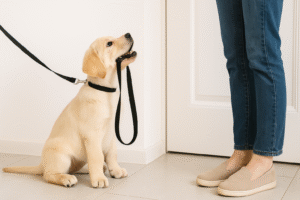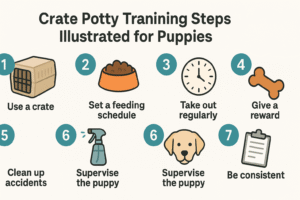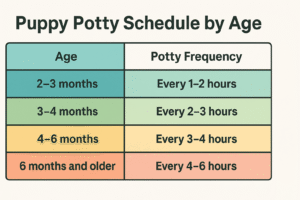What Is Puppy Potty Training and Why It Matters
Potty training (or house training) teaches your puppy where and when to go to the bathroom. It’s one of the first and most important lessons for a new pet parent.
When done right, it helps your puppy develop bladder control, keeps your home clean, and builds trust between you and your furry friend.

How Crate Training Helps
A properly sized crate mimics a den—dogs naturally avoid soiling where they sleep. Crate training for potty training uses this instinct to teach your puppy to “hold it” until you take them outside.
Consistency Is Key
Routine is everything. Feeding, playtime, and bathroom breaks should happen on a set schedule so your puppy learns predictable patterns. The more consistent you are, the faster your puppy becomes reliably house trained.
How Long Does It Take to Potty Train a Puppy?

Most puppies are fully house trained between 4 – 6 months of age, though smaller breeds may take longer. Early consistency can shorten that window dramatically.
Factors That Affect Progress
-
Age: Younger puppies need more frequent breaks.
-
Breed: Toy breeds have smaller bladders.
-
Diet & feeding schedule: Predictable meals = predictable potty times.
-
Owner consistency: Missed potty breaks lead to confusion.
Signs of Progress
-
Puppy waits near the door or crate to signal you.
-
Fewer indoor accidents.
-
Goes potty quickly when you take them outside.
How to Potty Train a Puppy Using a Crate (Step-by-Step)

Crate training is one of the easiest and most effective potty training methods. Follow this simple plan.
Step 1: Choose the Right Crate
Pick a crate large enough for your puppy to stand, turn, and lie down—but not big enough to use one side as a toilet.
👉 See our gear guide: Best Dog Crates for Potty Training Puppies
Step 2: Introduce the Crate Positively
Keep the crate open and inviting. Toss treats inside, feed meals in it, and never force your puppy. You want them to see it as a cozy safe spot, not punishment.
Step 3: Set a Regular Feeding & Potty Schedule
Feed your puppy on schedule (3–4 times daily). Take them outside:
-
Right after waking up
-
After meals and play
-
Before bedtime
Step 4: Use Frequent, Timed Breaks
For young puppies, a good rule is:
Age in months + 1 = hours they can hold it.
Example: A 3-month-old puppy can wait about 4 hours.
Step 5: Reward Immediately
When your puppy pees or poops outside, mark the moment with praise or a small treat. Timing matters—reward within 2 seconds to reinforce the behavior.
Step 6: Handle Accidents Calmly
Never scold or rub their nose in it. Instead, clean thoroughly with an enzyme-based cleaner to remove odor (dogs may re-mark smelly spots).
Step 7: Expand Freedom Gradually
As accidents decrease, let your puppy explore more rooms while supervised. Over time, the entire home becomes their “den.”
Outdoor Potty Training: Teaching Your Puppy to Pee & Poop Outside
Some owners prefer direct outdoor training or combine it with crate use.
Teach the “Go Potty” Cue
Each time you take your puppy outside, say “Go potty” or “Do your business.” Over days, they’ll associate the phrase with the action.
Pick a Dedicated Spot
Choose one grassy area near the door. The familiar scent encourages your puppy to return and reinforces the routine.
Timing Matters
Most puppies need to go:
-
Within 15 minutes of eating or drinking
-
After waking up
-
After intense play
When Puppy Refuses to Go Outside
Stay calm, leash them, and wait quietly for 5–10 minutes. If nothing happens, return inside for 10 minutes and try again. Avoid turning it into playtime.
👉 For stubborn cases, see How to Crate Train a Puppy in 7 Days for structure and patience techniques.
House Training Schedule by Puppy Age
| Puppy Age | Daytime Potty Frequency | Night Potty Breaks | Notes |
|---|---|---|---|
| 8 weeks | Every 1–2 hours | Every 3–4 hours | Introduce crate & pads |
| 12 weeks | Every 2–3 hours | 1 night trip | Strong bladder development begins |
| 16 weeks | Every 3–4 hours | Possibly none | Transition fully outdoors |
| 6 months+ | Every 4–6 hours | Usually none | Maintain schedule & praise |
Consistency shortens training time dramatically.
Common Potty Training Problems & How to Fix Them

Puppy Peeing in the Crate
-
Crate may be too large—add a divider.
-
Remove bedding temporarily if it absorbs accidents.
-
Clean with enzyme spray to remove scent cues.
Puppy Pooping Indoors After Going Outside
Your puppy might not have fully finished. Stay outside longer (5–10 minutes) or reward after both pee and poop.
Night-Time Accidents
-
Limit water 2 hours before bed.
-
Take out for one last break right before sleeping.
-
Use a small bedtime snack to settle them.
When You Work Full-Time
If you can’t come home midday, arrange a dog walker, neighbor, or use an exercise pen with potty pads.
See also: How to Potty Train a Puppy When You Work
Stubborn or Older Puppies
Go back to basics—shorter crate times, frequent breaks, consistent praise. Even 6-month-old or adopted dogs can relearn.
Potty Training Tools & Supplies That Help
1. Best Crates for Potty Training
Wire crates with dividers grow with your puppy.
👉 See our roundup: Best Dog Crates for Home Training in 2025
2. Puppy Pads vs. Outdoor Training
Pads can help apartment dwellers but may confuse some puppies. Transition gradually from pads to the door, then outside.
3. Enzyme-Based Cleaners
Essential for removing lingering smells. Pet-safe brands like Nature’s Miracle are recommended.
4. Potty Bells & Training Sprays
Bells teach your dog to alert you when they need to go; attractant sprays help mark the potty area.
5. Dog Litter Box or Indoor Turf
Great for city living or winter weather. Learn more in Safe & Unsafe Foods for Dogs and Cats (cross-cluster nutrition link for consistent interlinking).
Expert Tips for Faster House Training
Stick to a Routine
Feed, walk, and potty at the same times daily. Dogs thrive on predictability.
Use Positive Reinforcement
Reward good behavior with treats, praise, or clicker training.
See Positive Reinforcement Training Explained for deeper insight.
Track Progress
Keep a potty log to identify patterns. Apps or simple notebooks work well.
Limit Free Roaming
Use baby gates or pens until your puppy proves trustworthy.
Know the Bladder Rule
Puppies can hold it for roughly one hour per month of age, up to about 8 hours maximum in adulthood.
FAQs About Puppy Potty Training
How long does it take to potty train a puppy using a crate?
Most puppies learn the basics within 2–4 weeks, but full reliability may take several months depending on consistency and breed.
Should I use puppy pads or go straight to outdoor training?
If you’re home most of the day, outdoor training is best. Pads are fine temporarily for apartments or long work hours—just phase them out later.
How do I potty train a puppy while working full-time?
Use a crate for short periods and hire a midday walker. Alternatively, set up a playpen with a pad area to avoid accidents.
Why does my puppy pee inside after going outside?
They may not be fully emptying. Stay out a bit longer and reward only after both pee and poop.
Can older dogs be crate trained for potty training?
Absolutely. Adult dogs can relearn habits with consistency and positive reinforcement.
Conclusion
Potty training a puppy isn’t about perfection—it’s about patience and consistency. By combining crate training, a regular schedule, and positive reinforcement, you’ll build habits that last a lifetime.
Celebrate every small win and remember: accidents are part of learning. Stay calm, stay consistent, and your puppy will soon be a perfectly house-trained companion.
Next Read:
